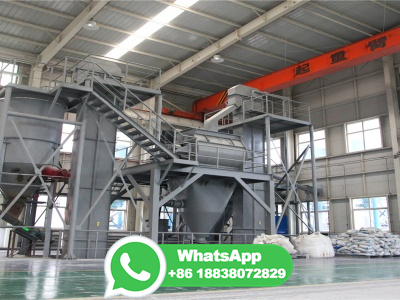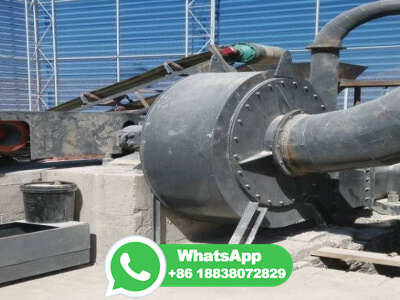
Bauxite via the Bayer process. This process will be briefly introduced in the following, as well as the reduction to aluminium, the anodes production and further steps of primary production. Alumina Production (Bayer Process) The aluminium production starts with the production of alumina from bauxite according to the socalled Bayer process.
WhatsApp: +86 18838072829
Introduction. Bauxite residue, or red mud, is a solid waste produced from the alumina refining of bauxite ore. Red mud is mostly collected from the Bayer process which uses sodium hydroxide to dissolve the aluminium silicate. Typically, about 1 to tonnes of red mud remains from the production of 1 t of alumina (Zhang et al., 2011).
WhatsApp: +86 18838072829
The sulfur in highsulfur bauxite not only pollutes the environment but also harms alumina production. This study investigated the removal of sulfur from highsulfur bauxite by adding Zn or ZnO during the Bayer process. The results showed that the different valence sulfur (S2−, S2O32−, SO32−, and SO42−) in sodium aluminate solution can be effectively removed by adding Zn during the ...
WhatsApp: +86 18838072829
The ore is first converted into pure aluminum oxide by the Bayer Process, and this is then electrolyzed in solution in molten cryolite another aluminum compound. The aluminum oxide has too high a melting point to electrolyse on its own. The usual aluminum ore is bauxite. Bauxite is essentially an impure aluminum oxide.
WhatsApp: +86 18838072829
The Bayer process is a chemical process for refining aluminium hydroxide, Al(OH) 3 from bauxite; this aluminium hydroxide is subsequently calcined to produce alumina, Al 2 O basis of the Bayer process is an understanding of the characteristics of the sodiumhydroxide—sodiumaluminate solution relationship, namely its ability to keep sodiumaluminate in a dissolved state over a wide ...
WhatsApp: +86 18838072829
The major portions of the impurity enter the Bayer process through bauxite. Beyond the critical levels the impurities alter the kinetics of the process. Among the various impurities, organic carbon is the most prominent one that affects the precipitation operation and the product quality, depending on the level of organic with respect to the ...
WhatsApp: +86 18838072829
ONE OF A FOURBOOK COLLECTION SPOTLIGHTING CLASSIC ARTICLES Five decades of landmark original research findings and reviews Highlighting some of the most important findings reported over the past five decades, this volume features some of the best technical papers published on alumina and bauxite from 1963 to 2011. Papers have been divided into thirteen subject sections for ease of access.
WhatsApp: +86 18838072829
Bauxite, the most important ore of aluminium, contains only 3054% alumina, Al 2 O 3, the rest being a mixture of silica, various iron oxides, and titanium alumina must be purified before it can be refined to aluminium metal. In the Bayer process, bauxite is washed with a hot solution of sodium hydroxide, NaOH, at 175°C (called digestion).
WhatsApp: +86 18838072829
The Bayer process was invented 130 years ago and remains the global method of choice for converting bauxite to alumina for aluminum and industrial alumina production. In general, the three largest problems in the Bayer process are as follows: (a) The removal of silica (a problem with high silica bauxite). (b)
WhatsApp: +86 18838072829
The principal components of bauxite ores are aluminum, iron, and siliconbearing minerals. In the Bayer process for recovery of alumina from bauxite,1 aluminum is dissolved into hot alkaline solution whilst iron is relatively insoluble. "Reactive silica" in the form of silicate minerals, such as kaolinite, typically dissolves and reprecipitates as sodium aluminum hydrosilicate, known as ...
WhatsApp: +86 18838072829
The digestion behavior of Australian gibbsiteboehmite bauxite and pure quartz in the Bayer process at 230250 °C was systematically studied in this paper. The mineral composition and morphology of the reaction products were characterized and the kinetics of the quartz dissolution process was studied in detail. It was shown that boehmite in ...
WhatsApp: +86 18838072829
Bayer process is a leaching process of bauxite. This process is use to produce high purity alumina (needed in subsequent electrolysis process) by leaching bauxite by NaOH. Leaching is done in autoclave at high presuure ( 2530 atm) and high temperature (220 o C), which produces a soluble aluminate (2NaAlO 2 ), and from which we precipitate out ...
WhatsApp: +86 18838072829
Bauxite to Alumina: the Bayer Process is an introductory text on the refining of bauxite ore to alumina as the feedstock for aluminium production. Tony Bagshaw has spent most of his professional life in the international aluminium industry. He has put together a primer on the alumina refining (Bayer) process which can be used by educators at ...
WhatsApp: +86 18838072829
The Bayer Process is the most economic means of obtaining alumina from bauxite. Other processes for obtaining alumina from metal ores are also in use in some refineries, particularly in China and Russia, although these make up a relatively small percentage of global production. The process stages are: 1. Milling
WhatsApp: +86 18838072829
Bauxite is transformed into sodiumcontaminated gibbsite in the socalled Bayer process (32,33). Industrial Bayertype gibbsite can be redissolved in acids or in strongly basic solutions, and from these solutions all other aluminum compounds are produced including aluminum hydroxides and oxides (34,35) .
WhatsApp: +86 18838072829
Bauxite residue is the industrial solid waste discharged from the production of alumina by bauxite, which contains a certain amount of ferric oxide in a reddishbrown color, so it is also called "red mud", and is a typical nonferrous metallurgical solid waste (Wang et al. 2018; Xue et al. 2022).The varieties of bauxite residue depend on the grade of the bauxite and alumina production process.
WhatsApp: +86 18838072829
Bauxite is mainly composed of alumina, silica, iron oxide and titanium dioxide. Around 70% of bauxite ore in the world adopts Bayer process to produce alumina. Then by HallHéroult electronic process, alumina can be reduced to pure aluminum. Bayer process steps for alumina production
WhatsApp: +86 18838072829
The Bayer process: How alumina is produced from bauxite. The Bayer process is carried out in four steps. First, after the bauxite is crushed, washed and dried, it is dissolved with caustic soda at high temperatures. Next, the mixture is filtered to remove the impurities, called "red mud," which is properly discarded.
WhatsApp: +86 18838072829
The aim of this work was to achieve an understanding of the distribution of selected bauxite trace elements (gallium (Ga), vanadium (V), arsenic (As), chromium (Cr), rare earth elements (REEs), scandium (Sc)) in the Bayer process. The assessment was designed as a case study in an alumina plant in operation to provide an overview of the trace elements behaviour in an actual industrial setup.
WhatsApp: +86 18838072829
The Bayer process is used worldwide for the alumina production. This process involves the alkaline leaching of bauxite to extract Al, followed by the precipitation of Al(OH) 3 to recycle the solution [1,2,3].The leaching process results in the formation of a solid residue, commonly referred to as a bauxite residue, which consists of iron minerals, hydrous aluminosilicates, which are formed ...
WhatsApp: +86 18838072829